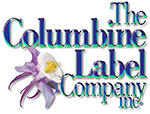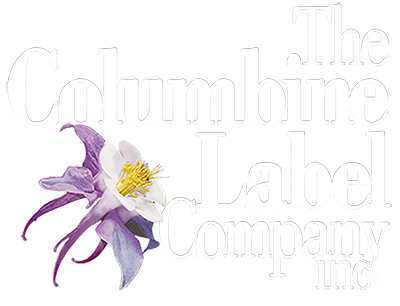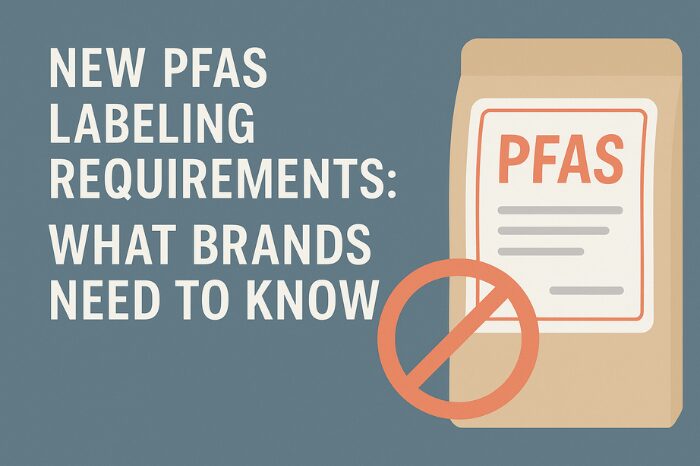As regulators and consumers grow more concerned about the environmental and health impacts of PFAS, also known as “forever chemicals”, a new wave of legislation is starting to impact packaging materials. Several states have passed or are considering laws that require disclosure, or even outright bans, of PFAS in food packaging and other consumer products.
For brands that rely on custom product labels, it’s time to pay close attention. While much of the legislation focuses on broader packaging materials, labels are increasingly being included in these regulations. Let’s break down what PFAS are, where legislation stands today, and how it could impact your product labels.
What Are PFAS, and Why Are They Being Regulated?
PFAS (per- and polyfluoroalkyl substances) are a large group of man-made chemicals used for their water and grease resistant properties. They’ve been found in everything from nonstick cookware to takeout containers, and yes, even in some inks, adhesives, and coatings used in packaging.
Known as “forever chemicals,” PFAS don’t break down naturally and have been linked to environmental contamination and potential health concerns, including hormonal disruption, immune system issues, and cancer. Because of this, states and countries are starting to regulate PFAS in consumer goods, especially in products that touch food or are likely to enter the waste stream.
Current PFAS Regulations in the U.S.
Regulations are evolving rapidly, and what applies today could change in the near future. But here’s where things stand as of mid-2025:
States with PFAS Packaging Restrictions or Bans:
-
California: Bans PFAS in plant-based food packaging and requires disclosure if present.
-
Maine: Requires manufacturers to report PFAS in products sold in the state and aims to ban most uses by 2030.
-
Washington: Prohibits PFAS in food packaging where safer alternatives are available.
-
New York: Has banned PFAS in food packaging since 2023.
Several other states including Minnesota, Vermont, and Connecticut have either introduced legislation or enacted phased bans that will go into effect within the next few years.
Are Labels Affected by PFAS Regulations?
This is where things get nuanced. Label materials aren’t always called out explicitly in legislation, but they often fall under broader definitions of “packaging.”
Here’s what may be impacted:
-
Topcoats and Laminates: Some label finishes that enhance gloss, durability, or water resistance may contain fluorochemicals.
-
Adhesives: While less common, some older adhesive formulations may include PFAS derivatives.
-
Flexible Packaging Labels: For flexible pouches or stick packs, the label might be part of the total film structure and therefore part of the regulated packaging.
-
Direct-Food Contact Labels: If your label touches the product directly (like on produce, bakery items, or to go coffee lids), it’s more likely to come under scrutiny.
Even when PFAS aren’t present in your labels, increasing legislation is pushing for disclosure and documentation. You may be asked by customers or retailers to prove that your labels are PFAS free.
What Brand Owners Should Do Now
1. Ask Your Label Supplier About PFAS-Free Options
Start the conversation with your label printer. Ask if any of your current materials contain PFAS or if alternatives are available. At Columbine Label, we’re already primarily PFAS free and helping new customers transition to substrates and adhesives that meet new regulatory standards.
2. Audit Your Packaging System
PFAS could be in more than just the label. Work with your packaging partners to assess films, coatings, liners, and adhesives throughout your system.
3. Stay Ahead of the Regulations
Even if you don’t sell in California or Maine today, legislation is moving quickly. Assume that PFAS disclosure or bans will be coming to more states and plan accordingly.
4. Document and Disclose
Retailers and manufacturers may start asking for documentation that your labels are PFAS-free. Make sure your suppliers can provide the appropriate declarations or certifications.
How Columbine Label Is Responding
As a label supplier committed to both quality and regulatory compliance, Columbine Label is actively monitoring PFAS regulations across the U.S. We’ve already worked with suppliers to source PFAS-free adhesives, inks, and laminates when needed and can help you make the transition with minimal disruption.
If you sell in a state with PFAS disclosure laws, or you just want to future proof your packaging, we’re here to help. We can assist you with selecting compliant materials, supplying documentation, and keeping you informed about changing requirements.
PFAS and the Bigger Picture
The push for PFAS-free packaging is part of a broader trend toward cleaner, safer materials and greater transparency in the supply chain. From Prop 65 warnings to the FDA’s evolving definitions of “healthy,” label compliance is no longer just a regulatory checkbox, it’s a critical brand trust issue.
Consumers want to know what’s in their products and packaging. Retailers want assurance that goods meet environmental standards. Governments are moving to eliminate harmful chemicals. Labels, small but mighty, are right in the middle of it all.
Final Thoughts: A Smart Label Is a Compliant Label
PFAS regulations are only going to increase, and brands that are proactive will be better positioned to adapt quickly. Your label may be just one piece of your product packaging, but it can have outsized importance when it comes to compliance, consumer trust, and product perception.
Have questions about how PFAS laws could affect your labels or packaging materials? Reach out to Columbine Label. We’re here to help you label smarter, today and for the future.


